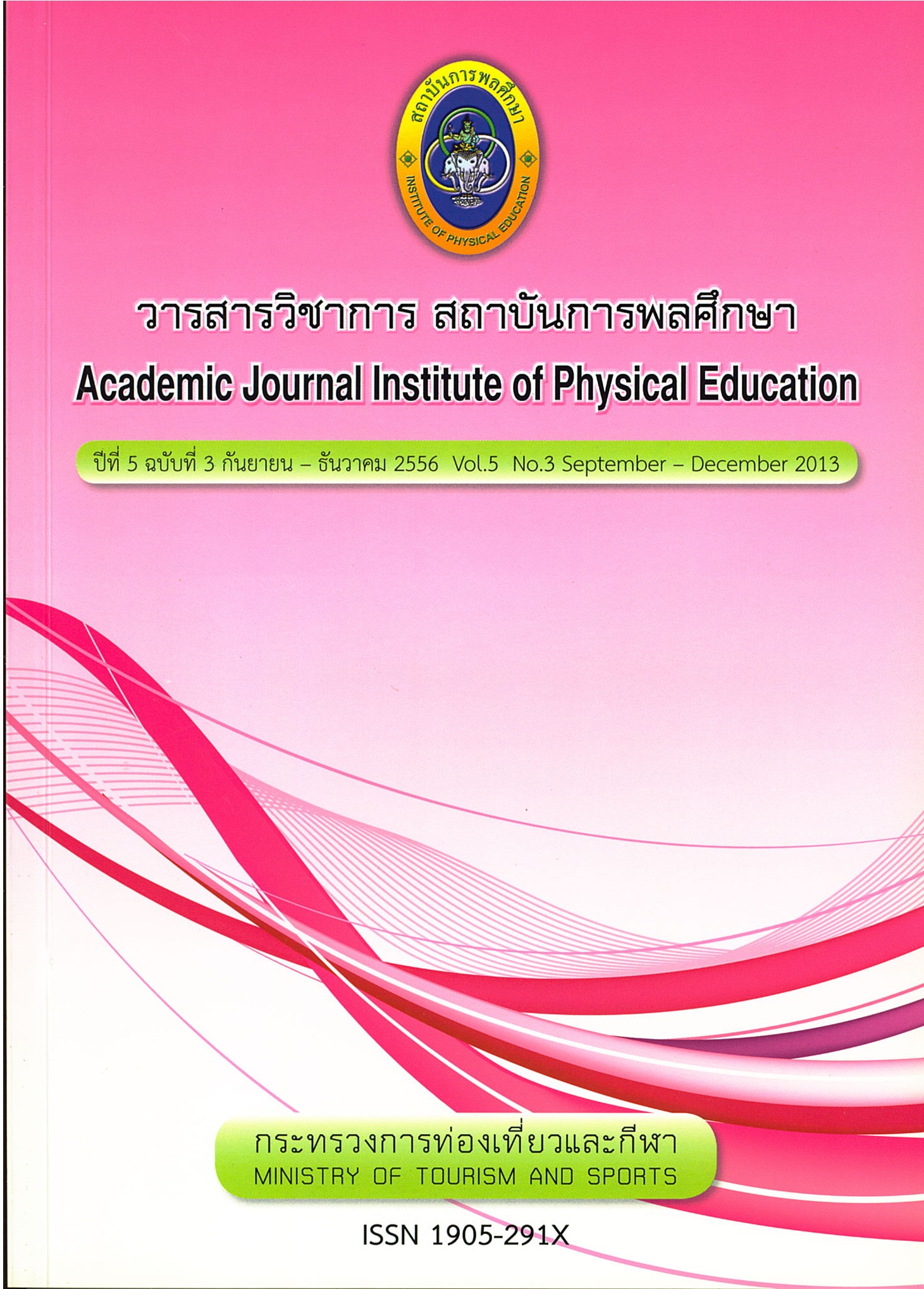The Effects of the First Monkol Intensive Muay-Thai Study Curriculum on Health-Reklated Physical Fitness, Thai Martial Art's Skills and Attitudes of Second Key Stage Students in Bangkok Metropolis Schools
Main Article Content
Abstract
The purposes of this study were to study the results of the first monkol Intensive Muay-Thai Suksa on health-related physical fitness, Thai martial art's skills and attitudes of second key stage students in Bangkok Metropolis schools. The second key stage samples comprised of 60 students. The second key stage samples were assigned into 2 groups. Thirty students were assigned to an experimental group and were studied Intensive Muay-Thai Suksa (Monkol 1) for 10 weeks, 3 days a week, and 1 hour a day. The other 30 students were assigned to a control group and were taken general physical education classes. The researcher examined health-related physical fitness of the experimental group and the control group before and after the experiment. The obtained data were analyzed in terms of means, standard deviations, and analysis of covariance. Thai martial art's skills were examined after the experiment, the results were analyzed by percentile and were summarized as an essay. Students were observed and were conducted focus group discussion after the experiment, the results were analyzed for attitudes and characteristics, and then were concluded as an essay.
The results were as follows;
- After studied Intensive Muay-Thai Suksa (Monkol 1), all dimensions of healthrelated physical fitness of students were significant difference from before studied Intensive Muay Thai Suksa (Monkol 1) at .05 level except body composition and the flexibility of the experimental group were significant difference from the control group at .05 level.
- Students were able to perform every skills of Intensive Muay-Thai Suksa (Monkol 1).
- Students had good attitudes, being-Thai values, unity, and diligence.
Article Details
The published article is a copyright of the Academic Journal of Thailand National Sports University. The passage appeared in each article in this academic journal is a perspective of each author which is not related to the journal. Each author is required to be responsible for all components of his/her own article. If there are any mistakes, each author must be responsible for those mistakes on his/her own.
References
ชาญณรงค์ สุหงษา, คู่มือการสอนมวยไทยเบื้องต้น, พิมพ์ครั้งที่ 1. กรุงเทพฯ: บรรณกิจ, 2545
ทิชา สังวรกาญจน์, ผลของการฝึกโปรแกรมการออกกําลังกายด้วยท่ารํากระบี่ที่มีต่อสุขสมรรถนะ และการทรงตัวของผู้สูงอายุ, วิทยานิพนธ์ปริญญามหาบัณฑิต สาขาวิทยาศาสตร์การกีฬา สํานักวิชาวิทยาศาสตร์การกีฬา. จุฬาลงกรณ์มหาวิทยาลัย, 2551.
ทิศนา แขมมณี, ศาสตร์การสอน: องค์ความรู้เพื่อการจัดกระบวนการเรียนรู้ที่มีประสิทธิภาพ. กรุงเทพฯ: สํานักพิมพ์แห่งจุฬาลงกรณ์มหาวิทยาลัย, 2551.
ธานินทร์ บุญญาลงกรณ์, เจตคติของนักเรียนมัธยมศึกษาตอนต้นที่มีต่อวิชาพลศึกษาตามหลักสูตรการศึกษาขั้นพื้นฐาน พุทธศักราช 2544. วิทยานิพนธ์ปริญญาครุศาสตรมหาบัณฑิต สาขาวิชาพลศึกษา ภาควิชาหลักสูตรการสอนและเทคโนโลยีการศึกษา คณะครุศาสตร์ จุฬาลงกรณ์มหาวิทยาลัย, 2547.
วิชิต ชี้เชิญ, สัมภาษณ์. 17 กรกฎาคม 2552, 12 มีนาคม 2554 และ 20 มีนาคม 2555.
วรรณา จันทร์เพ็ญ, เจตคติของนักเรียนระดับมัธยมศึกษาตอนต้นที่นับถือศาสนาอิสลามที่มีต่อวิชาพลศึกษา วิทยานิพนธ์ปริญญาการศึกษามหาบัณฑิต. วิชาเอกพลศึกษา มหาวิทยาลัยศรีนครินทรวิโรฒประสานมิตร, 2543.
ศึกษาธิการ, กระทรวง, หลักสูตรแกนกลางการศึกษาขั้นพื้นฐานพุทธศักราช 2551. กรุงเทพฯ: ชุมนุมสหกรณ์การเกษตรแห่งประเทศไทย, 2552.
สุจิตรา สุคนธทรัพย์, การวิเคราะห์คุณลักษณะไทย คุณค่า และกระบวนการถ่ายทอดศิลปะการต่อสู้ป้องกันตัวแบบไทย : กระบี่กระบอง, วิทยานิพนธ์ปริญญาครุศาสตร์ดุษฎีบัณฑิต สาขาวิชาพัฒนศึกษา ภาควิชาสารัตถศึกษา บัณฑิตวิทยาลัย จุฬาลงกรณ์มหาวิทยาลัย, 2540.
สุจิตรา สุคนธทรัพย์ และคณะ, รายงานการวิจัยเรื่อง ศิลปะการต่อสู้ป้องกันตัวแบบไทย : คุณค่าแท้และกระบวนการถ่ายทอด กรณีศึกษาครูวิชิต ชี้เชิญ. ทุนวิจัยสํานักงานคณะ กรรมการวัฒนธรรมแห่งชาติ, 2550.
สถาบันอาศรมศิลป์ ภูมิปัญญากีฬาไทย: More than sport. กรุงเทพฯ: แปลนพริ้นติ้ง, 2553.

